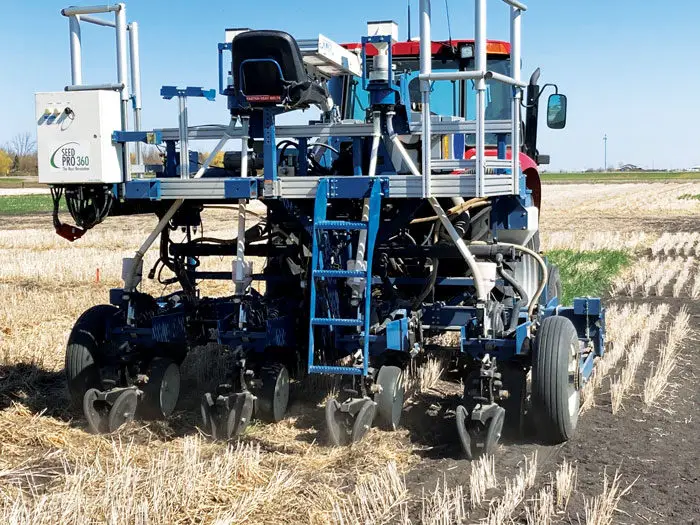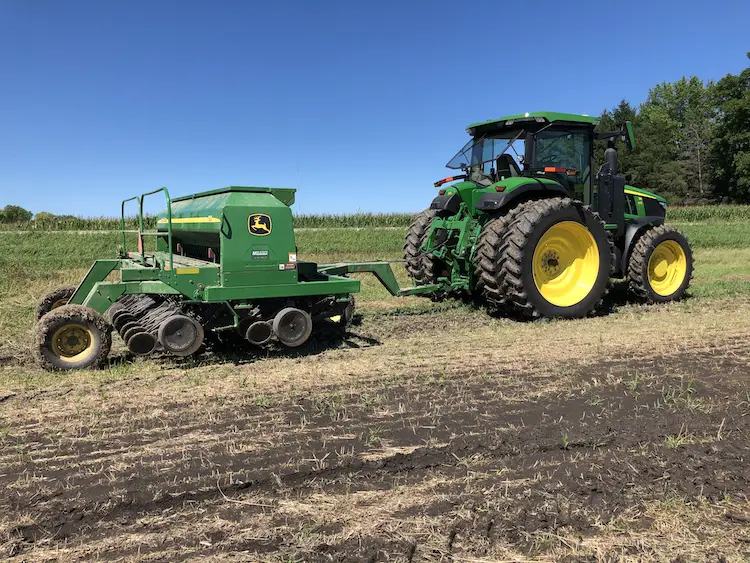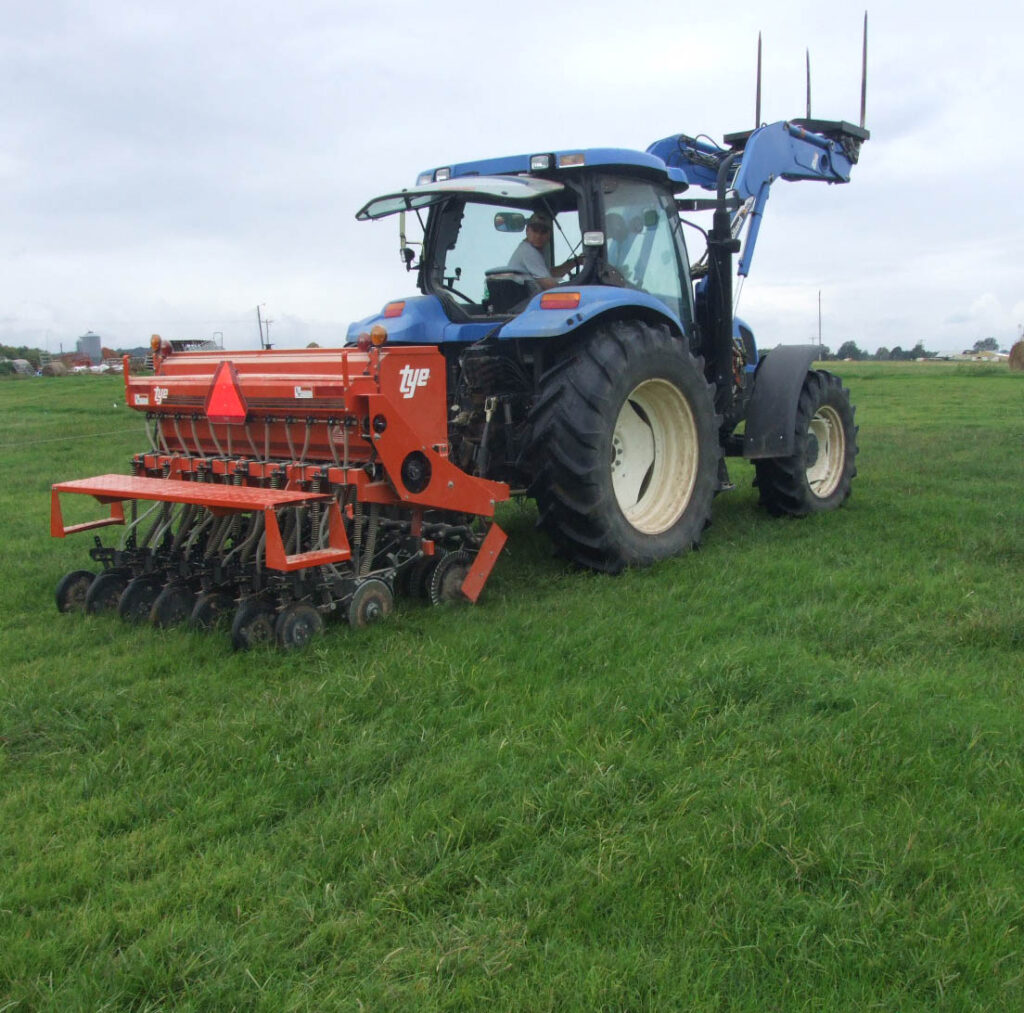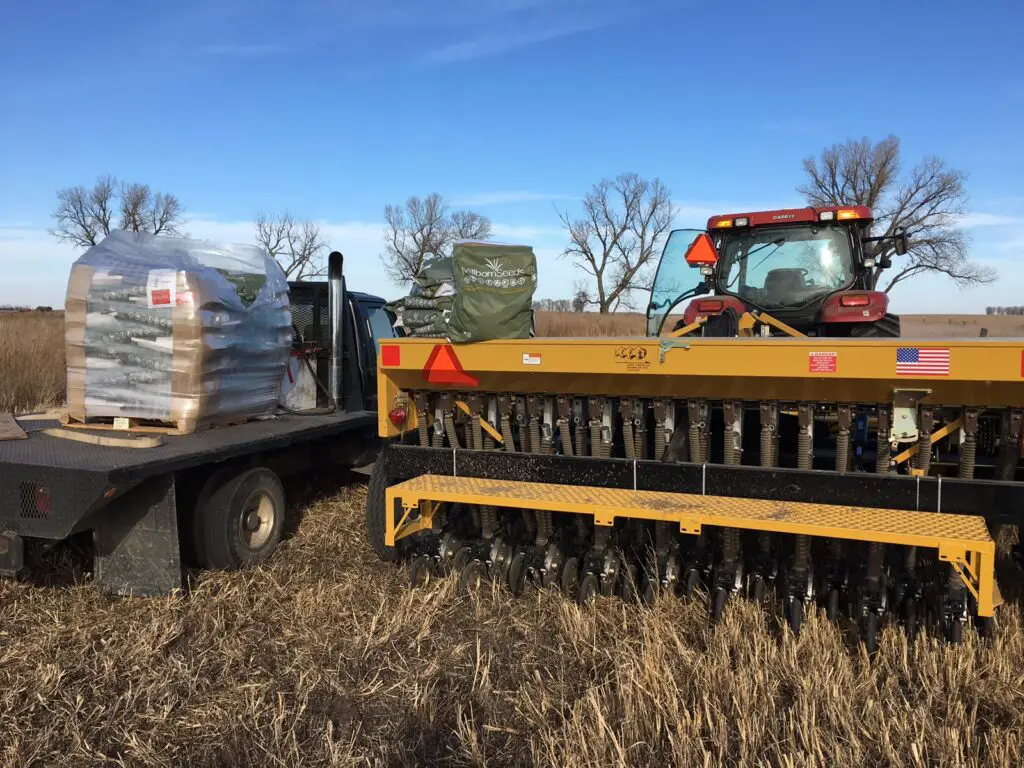This post may contain affiliate links which means I may receive a commission for purchases made through links. Learn more on my Private Policy page.
Are you new to using a grain drill and looking for some guidance on the best practices? Look no further! In this article, we will explore the top tips and techniques for effectively using a grain drill. Whether you are a seasoned farmer or just starting out, these practices will help you maximize the efficiency and productivity of your planting process. From selecting the right seed to adjusting the depth and spacing, we’ve got you covered. So, grab your notebook and let’s dive into the world of grain drill best practices!

This image is property of www.covercropstrategies.com.
Choosing the Right Grain Drill
Assessing the crop and soil conditions
When it comes to choosing the right grain drill, one of the first steps is to assess the crop and soil conditions. Different crops may have varying seeding requirements, and soil conditions can also impact the effectiveness of the drill. Factors to consider include the type of soil, its moisture content, and its fertility levels. By understanding the specific needs of your crop and the condition of your soil, you can select a grain drill that is best suited for optimal seeding.
Considering the size and type of operation
The size and type of your operation also play a crucial role in determining the right grain drill for your needs. If you have a small-scale operation, a smaller grain drill may be more suitable. On the other hand, larger operations may benefit from larger drills that can cover more ground efficiently. It’s important to consider your available resources, such as manpower and equipment, as well as your overall goals and objectives for the operation. By taking these factors into account, you can choose a grain drill that aligns with the scale and type of your operation.
Weighing the pros and cons of different drill types
There are various types of grain drills available in the market, and each comes with its own set of pros and cons. Some common types include the no-till drill, the air seeder, and the traditional grain drill. The no-till drill is known for its ability to seed directly into untilled soil, while the air seeder uses air pressure to distribute seeds. Traditional grain drills, on the other hand, are simpler and more cost-effective. When making a choice, it’s important to consider factors such as cost, ease of use, and the specific requirements of your operation. By weighing these pros and cons, you can select a drill type that best suits your needs.
Preparing the Grain Drill
Cleaning the drill thoroughly
Before using a grain drill, it is essential to clean it thoroughly. Over time, dirt and debris can accumulate on the drill, which can affect its performance. By cleaning the drill, you can remove any residue that could hinder seed distribution. Pay attention to the seed boxes, metering units, and any other components that come into contact with the seeds. Thoroughly cleaning the drill will help ensure accurate seed placement and prevent potential issues during the seeding process.
Inspecting and replacing worn parts
Regular inspections of the grain drill are crucial for identifying any worn or damaged parts. Components such as openers, seed tubes, and disc blades should be inspected for signs of wear and tear. If any parts are found to be worn or damaged, they should be promptly replaced. This will help maintain the efficiency and effectiveness of the grain drill, preventing any issues that may arise due to faulty parts. By regularly inspecting and replacing worn parts, you can keep your drill in optimal condition and maximize its performance.
Calibrating the drill for accurate seeding
To ensure accurate seed placement, it is important to calibrate the grain drill. Calibration involves adjusting the settings of the drill to achieve the desired seed spacing and population. This process may vary depending on the specific make and model of the drill. Calibration typically involves measuring the seed drop rate and adjusting the metering mechanism accordingly. By calibrating the drill, you can achieve consistent seed placement and optimize the effectiveness of the seeding process.
Setting Seed Depth and Spacing
Determining the ideal seed depth
The ideal seed depth varies depending on the type of crop being seeded. It is important to determine the appropriate seed depth for your crop to ensure optimal germination and growth. Factors such as soil moisture and temperature should be considered when determining the seed depth. Generally, seeds should be planted at a depth that allows for proper soil-to-seed contact without burying them too deeply. Consulting seed guidelines or seeking advice from agricultural experts can help determine the ideal seed depth for your specific crop.
Adjusting the drill for uniform seed spacing
Uniform seed spacing is important for maximizing crop yield and minimizing competition among plants. To achieve uniform seed spacing, the grain drill should be properly adjusted. This may involve adjusting the seed metering mechanism, ensuring proper seed tube alignment, and fine-tuning other components of the drill. By achieving uniform seed spacing, you can promote even growth and reduce the risk of overcrowding in the field.
Considering the specific crop requirements
Different crops have varying requirements when it comes to seed depth and spacing. It is essential to consider the specific requirements of your crop when setting the seed depth and spacing. Some crops may require deeper seed placement to establish strong root systems, while others may thrive with shallower planting depths. Additionally, certain crops may benefit from wider or narrower seed spacing depending on their growth habits and nutrient requirements. By considering the specific crop requirements, you can ensure optimal seed placement and promote healthy crop growth.
Ensuring Proper Seed Placement
Placing the seed at the right depth
Proper seed placement is crucial for successful germination and establishment. Seeds that are planted too shallow may dry out or be subject to damage from pests or weather conditions. On the other hand, seeds that are planted too deep may struggle to emerge or may use up too much energy, resulting in weak growth. It is important to follow the recommended seed depth guidelines for your specific crop to ensure optimal seed placement.
Avoiding seed damage or displacement
When seeding with a grain drill, it is important to take precautions to avoid seed damage or displacement. The seed should be handled gently to prevent cracking or crushing, as damaged seeds may not germinate. Additionally, the drill should be operated at a speed that allows for smooth and controlled seed placement, minimizing the risk of seed displacement. By being mindful of seed handling and ensuring proper drilling techniques, you can prevent seed damage or displacement and promote successful germination.
Using depth control mechanisms effectively
Many modern grain drills are equipped with depth control mechanisms that allow for precise seed placement. These mechanisms, such as depth wheels or press wheels, help ensure uniform seed depth across the entire seeding area. It is important to properly adjust and utilize these depth control mechanisms to achieve consistent seed placement. By using these mechanisms effectively, you can enhance the accuracy and effectiveness of seed placement, leading to improved crop establishment.

This image is property of www.no-tillfarmer.com.
Maintaining Proper Ground Speed
Understanding the importance of ground speed
Maintaining the proper ground speed is essential for achieving even seed distribution. Ground speed refers to the speed at which the grain drill travels across the field. If the ground speed is too fast, seeds may be spread unevenly, resulting in patchy germination and growth. Conversely, if the ground speed is too slow, seeds may accumulate in certain areas, leading to overcrowding. Understanding the importance of ground speed and its impact on seed distribution is crucial for achieving optimal planting results.
Maintaining consistent speed for even seeding
To ensure even seed distribution, it is important to maintain a consistent ground speed throughout the entire seeding process. The speed at which the drill is pulled should be steady and controlled. Sudden increases or decreases in ground speed can result in uneven seed placement. By maintaining a consistent speed, you can promote even seeding and enhance the overall effectiveness of the grain drill.
Adapting speed to varying field conditions
Field conditions can vary, and it is important to adapt the ground speed accordingly. Factors such as soil moisture, field slopes, and obstacles can affect the performance of the grain drill. In wet or challenging terrain, it may be necessary to reduce the ground speed to maintain control and ensure proper seed distribution. Conversely, in favorable conditions, a slightly higher ground speed may be feasible without compromising the quality of seeding. By adapting the ground speed to varying field conditions, you can optimize the performance of the grain drill and achieve the desired seeding outcomes.
Implementing Proper Fertilizer Application
Applying fertilizer concurrently with seeding
Applying fertilizer concurrently with seeding can be an efficient way to provide essential nutrients to the emerging crop. When using a grain drill, it is important to ensure that the fertilizer is evenly mixed with the seed and distributed throughout the field. This can be achieved by incorporating a fertilizer attachment or utilizing integrated fertilizer mechanisms on the grain drill. By applying fertilizer concurrently with seeding, you can promote early nutrient uptake and support healthy crop growth.
Mixing and distributing fertilizer evenly
Proper mixing and distribution of fertilizer are essential for achieving uniform nutrient application. The fertilizer should be thoroughly mixed with the seed to avoid clumping or uneven distribution. Modern grain drills often have fertilizer distribution systems that ensure even fertilizer application. It is important to properly calibrate and adjust these systems to achieve the desired fertilizer distribution. By mixing and distributing fertilizer evenly, you can provide uniform nutrient availability for the developing crop.
Taking precautions to avoid fertilizer burn
Fertilizer burn can occur when excessive fertilizer comes into direct contact with the seeds or seedlings. This can lead to seed and plant damage. To avoid fertilizer burn, it is important to follow the recommended fertilizer rates and avoid over-application. Fertilizer should be placed at a safe distance from the seeds to prevent direct contact. Additionally, soil moisture levels should be monitored to ensure that excessive moisture does not increase fertilizer availability and potential burn risk. By taking precautions to avoid fertilizer burn, you can protect the seeds and seedlings from damage and promote healthy crop development.

This image is property of www.no-tillfarmer.com.
Addressing Soil Compaction
Recognizing the impact of soil compaction
Soil compaction can have a significant impact on crop growth and development. Compacted soil restricts root growth and reduces water and nutrient infiltration, leading to decreased crop yields. When using a grain drill, it is important to be aware of the potential for soil compaction and take measures to minimize its effects. Understanding the signs of soil compaction and its impact on crop health is crucial for implementing appropriate mitigation strategies.
Minimizing compaction risks during drilling
During the drilling process, the weight of the grain drill can contribute to soil compaction. To minimize compaction risks, it is important to avoid operating the drill in wet or excessively moist soil conditions. Wet soil is more prone to compaction, and operating heavy machinery in these conditions can exacerbate the issue. If possible, it is beneficial to allow the soil to dry before using the grain drill. Additionally, reducing the weight of the drill or utilizing flotation tires can help minimize compaction risks.
Implementing proper tillage practices
Proper tillage practices can help address soil compaction and create a favorable seedbed for optimal crop growth. Prior to drilling, it is important to properly prepare the soil through tillage. This may involve practices such as plowing, harrowing, or disking to alleviate compaction and create a loose and aerated soil structure. Implementing proper tillage practices can help create an ideal environment for seed germination and root development, improving crop performance in the long run.
Monitoring and Adjusting Seed Rate
Establishing the recommended seed rate
The recommended seed rate varies depending on the specific crop being seeded. It is important to determine the appropriate seed rate for your crop to ensure optimal plant density. Factors such as seed size, germination rate, and desired plant population should be considered when establishing the seed rate. Consulting seed guides or agricultural experts can provide valuable guidance in determining the recommended seed rate for your specific crop.
Periodically monitoring seed meter performance
Monitoring seed meter performance throughout the seeding process is important for ensuring accurate seed placement. Seed meters can occasionally malfunction or become clogged, leading to uneven seed distribution. By periodically monitoring the seed meter performance, you can identify any issues or irregularities and take appropriate action promptly. Regular maintenance and calibration of the seed meter are also recommended to maximize accuracy and optimize seed placement.
Making necessary adjustments for optimal seeding
Based on the monitoring of seed meter performance and seed placement, adjustments may need to be made to achieve optimal seeding. This may involve fine-tuning the seed meter settings, adjusting the drill depth, or addressing any other factors that may be affecting seed placement. By making necessary adjustments throughout the seeding process, you can improve the accuracy and effectiveness of seed placement, leading to better crop establishment and growth.

This image is property of www.millbornseeds.com.
Managing Weed and Pest Control
Using appropriate herbicides and insecticides
Weed and pest control are essential for protecting the crop from competition and potential damage. When using a grain drill, it is important to implement appropriate herbicide and insecticide treatments to manage weed and pest populations effectively. The choice of herbicides and insecticides should be based on the specific weed and pest species present in the field. It is recommended to consult agricultural experts or follow established guidelines to ensure proper selection and application of these control measures.
Timing treatments for maximum efficacy
The timing of herbicide and insecticide treatments plays a crucial role in their efficacy. It is important to properly time these treatments to ensure maximum effectiveness in controlling weeds and pests. This may involve considering factors such as the developmental stage of the crop, weed growth stage, or insect life cycle. By timing treatments appropriately, you can target weeds and pests at their most vulnerable stages, minimizing their impact on crop growth and yield.
Taking precautions to minimize environmental impact
While weed and pest control is important, it is equally important to take precautions to minimize the environmental impact of these treatments. Care should be taken to avoid excessive use of chemicals, as this can lead to environmental contamination and potential harm to non-target organisms. Following label instructions and utilizing integrated pest management practices can help minimize the use of chemicals and promote sustainable agriculture. By taking precautions to minimize environmental impact, you can protect not only your crop but also the overall ecosystem.
Collected Data Analysis and Record-Keeping
Analyzing seeding data for future improvements
Collecting and analyzing seeding data can provide valuable insights for future improvements. By monitoring factors such as seed placement accuracy, crop emergence rates, and yield performance, you can identify areas for potential optimization. Analyzing seeding data can help identify trends, patterns, or issues that may require attention or adjustments in future seeding operations. By taking a proactive approach to data analysis, you can continuously improve your seeding practices and maximize the productivity of your operation.
Maintaining detailed records of seeding operations
Maintaining detailed records of seeding operations is essential for effective farm management. These records serve as a valuable resource for tracking important information, such as field conditions, seed varieties, fertilizer applications, and other key parameters. Detailed records allow for easy reference and analysis, aiding in decision-making and troubleshooting. By consistently maintaining detailed records, you can establish a comprehensive history of your seeding operations and facilitate the evaluation of equipment performance and overall farm management practices.
Utilizing data to evaluate equipment performance
The data collected from seeding operations can be utilized to evaluate the performance of the grain drill and other associated equipment. By comparing data such as seed placement accuracy, seed spacing uniformity, and overall crop performance, you can assess the effectiveness and efficiency of the equipment used. This can help identify areas for improvement or potential equipment upgrades. By utilizing data to evaluate equipment performance, you can make informed decisions to optimize seeding operations and maximize the productivity of your farm.
In conclusion, using a grain drill efficiently requires a combination of proper preparation, strategic decision-making, and continuous monitoring. By selecting the right grain drill for your operation, preparing it thoroughly, setting the correct seed depth and spacing, ensuring proper seed placement, maintaining the appropriate ground speed, implementing proper fertilizer application, addressing soil compaction, monitoring and adjusting seed rate, managing weed and pest control, analyzing collected data, and maintaining detailed records, you can optimize the effectiveness and efficiency of your seeding operations. By following these best practices, you can lay the foundation for a successful crop season and achieve optimal yields.

This image is property of www.covercropstrategies.com.
This post may contain affiliate links which means I may receive a commission for purchases made through links. Learn more on my Private Policy page.

